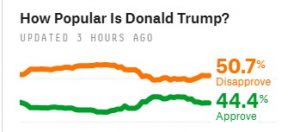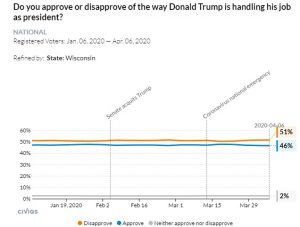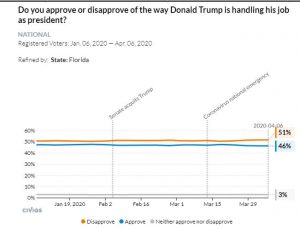At The Cook Political Report, Amy Walter ruminates on Democratic prospects for picking up a U.S. Senate seat in North Carolina, and says that the “suburbs are the most competitive region in the state. Clinton narrowly carried these urban suburbs in the 2016 election 49 to 48 percent. These types of suburbs also turned decidedly more Democratic in the 2018 election…The next question is whether an improvement in these suburbs would be enough for Democrats to win the state in 2020. Trump won the state by 3.6 percent. In 2016, the cities and those inner suburbs comprised 54 percent of the total vote. The rural areas plus the exurbs represented 46 percent of the vote. So, on paper, sure, win the cities and inner suburban areas, and you win the election. But it’s not that simple. Trump dominated the exurban and rural vote carrying rural areas by 24 points and the exurbs by 30 points. Clinton, meanwhile, had a solid showing in the cities — she won them by 35 points — but just barely eked out a win in the inner suburbs…Moreover, while the inner suburbs are turning bluer, it is highly unlikely that Democrats like Joe Biden or Senate nominee Cal Cunningham will pull out the double-digit margins there like they do in the cities. Instead, the key for Democrats will be to do better in those exurbs. According to [Catawba College professor Michael] Bitzer’s analysis, the dense suburban vote and the exurban vote each make up about a quarter of total votes cast. In other words, it’s not enough for Democrats to gain a couple of points in the inner suburbs if they are still losing the exurbs by 30 points.”
At a time when Republicans are panicking out about gowing support for voting by mail and the Republican majority of the U.S. Supreme Court has issued a ruling designed to escalate voter suppression, Virginia’s Democratic Governor Ralph Northam has “signed a series of new measures into law aimed at expanding access to voting in the commonwealth,” Paul LeBlanc reports at CNN Politics. “The new legislation will establish Election Day as a holiday, remove the requirement that voters show a photo ID prior to casting a ballot and, expand early voting to be allowed 45 days before an election without a stated reason.”
From “GOP Justices Decree Capital Punishment for Voting” by Harold Meyerson at The American Prospect: “The only reason that the Republican National Committee doesn’t have John Roberts, Clarence Thomas, Sam Alito, Neil Gorsuch, and Brett Kavanaugh on the payroll is that they know they have them for free…Yesterday, as in Bush v. Gore and Shelby County v. Holder (which struck down much of the Voting Rights Act), the Republican majority on the United States Supreme Court did its damnedest to throw an election to their very own Republicans. The Gang of Five overturned the ruling of a federal District Court that extended the period of absentee voting in Wisconsin for one week, to April 13…The Court’s ruling came roughly at the same time that their mini-me’s—four Republican justices on the Wisconsin Supreme Court—overturned Governor Tony Evers’s postponement of today’s Wisconsin primary until June. Alone among the 11 states that had primaries scheduled this month, Wisconsin—that is, the Republican majorities in the state legislature—decreed that this one would proceed despite the coronavirus shelter-in-place rule. Of course, today’s on-again-off-again-on-again-again election will be a travesty, with many, probably most, polling places closed due to a lack of poll workers. In Milwaukee, which, not coincidentally, is home to the largest concentration of the state’s Democrats, the usual 180 polling places have been consolidated to a mere five.”
In his article, “SCOTUS Just Set the Stage for Republicans to Steal the Election: In a 5-4 decision, the Supreme Court blocked Wisconsin from extending the absentee voting deadline, disenfranchising thousands and creating a terrible precedent” at The Nation, Elie Mystal puts it this way: “Three weeks ago, I wrote that the real threat to the 2020 election is not that Donald Trump will use the coronavirus to try to cancel it but that Republicans will try to steal it, state by state, county by county. In an election in which a record number of people may attempt to vote by absentee ballot, Republican state officials can choose simply to mail ballots to people in counties that traditionally vote for Republicans—and not mail enough ballots to the far more populous counties that traditionally vote for Democrats. In so doing, they can slant the general election toward Donald Trump and other Republicans running for election without Trump having to go through all the bother of declaring himself “dictator for life,” which might spook Mitt Romney…Last night, the Supreme Court gave Republicans the go-ahead to proceed with that scheme. You don’t need an army to cross the Rubicon when you have henchmen on the Supreme Court willing to do all the dirty work.”
Mystal continues: “Where normal people see a vast human tragedy, Republicans see an electoral opportunity. The entire Democratic theory of overthrowing Trump has been to inspire massive voter turnout. Turnout led from the urban centers and their close suburbs. The “blue wave.”But it is in these densely packed communities that Covid-19 is hitting the hardest. And there is already evidence that the African American community, the base of the Democratic party, is being disproportionately killed by the virus…Republicans can use all of this to their advantage. If people have to choose between risking their lives by going to vote, or staying home, most people will stay home—and who can really blame them? If Republicans can make it hard for people to vote absentee, particularly in high-population centers where there is going to be the most demand for absentee voting, Republicans can win…Wisconsin shows them how. Wisconsin shows that the Republican Supreme Court will not stop Republican local officials from disenfranchising people who stay home because of the coronavirus…The Wisconsin ordeal is to the November election as Italy’s outbreak was to our own. It’s where we can see what is coming for all of us, and what will happen to our country, if we don’t act soon enough.”
The tax deadline has been postponed till July 15th, but the soaring government expenses associated with the coronavirus crisis intensifies the debate about tax reform. At The Boston Review, Emanuel Saez and Gabriel Zucman provide a guide to needed reforms in their article, “Taxing the Superrich: For the sake of justice and democracy, we need a progressive wealth tax.” As the authors write, “Taxing the superrich involves three essential and complementary ingredients: a progressive income tax, a corporate tax, and a progressive wealth tax. The corporate tax ensures that all profits are taxed, whether distributed or not: it acts as a de facto minimum tax on the affluent. The progressive income tax ensures high earners pay more. And a progressive wealth tax gets the ultrarich to contribute to the public coffers even when they, including Buffett, manage to realize little taxable income. ..The middle class already pays taxes on its wealth, in the form of property taxes. The wealthy don’t, since most of their wealth consists of financial assets, which are exempt from the property tax.”
Re Amy McGrath’s campaign to unseat Mitch McConnell in the Kentucky Senate race, Jane Mayer observes in The New Yorker that “as covid-19 decimates the economy and kills Americans across the nation, McConnell’s alliance with Trump is looking riskier. Indeed, some critics argue that McConnell bears a singular responsibility for the country’s predicament. They say that he knew from the start that Trump was unequipped to lead in a crisis, but, because the President was beloved by the Republican base, McConnell protected him. He even went so far as to prohibit witnesses at the impeachment trial, thus guaranteeing that the President would remain in office. David Hawpe, the former editor of the Louisville Courier-Journal, said of McConnell, “There are a lot of people disappointed in him. He could have mobilized the Senate. But the Republican Party changed underneath him, and he wanted to remain in power…Stuart Stevens, a longtime Republican political consultant, agrees that McConnell’s party deserves a considerable share of the blame for America’s covid-19 disaster. In a forthcoming book, “It Was All a Lie,” Stevens writes that, in accommodating Trump and his base, McConnell and other Republicans went along as Party leaders dismantled the country’s safety net and ignored experts of all kinds, including scientists. “Mitch is kidding himself if he thinks he’ll be remembered for anything other than Trump,” he said. “He will be remembered as the Trump facilitator.”
“Responding to the unprecedented coronavirus pandemic poses serious challenges for governors across the country, including the nine set to face voters in November’s 11 gubernatorial elections,” Rebecca Klar writes in her article, “Coronavirus response could be key factor in tight governor’s races” at The Hill. “How state leaders handle their COVID-19 responses could have a particular impact in competitive races, such as those in North Carolina or Montana, where Gov. Steve Bullock (D) is running for the Senate and both parties are fighting hard to replace him…The pandemic and how state governments are handling it has significantly raised the profile of multiple governors, particularly New York’s Andrew Cuomo, who has seen his highest favorability ratings in seven years and had to repeatedly deny that he is considering a presidential run…But Cuomo and many others in the coronavirus spotlight, such as Maryland Gov. Larry Hogan (R) or Louisiana Gov. John Bel Edwards (D), aren’t facing voters in November. Others managing hot spots, such as Washington Gov. Jay Inslee (D), have seen boosts in public polling over their COVID-19 responses, though that may not weigh heavily on the result of their races…Governors across the country have generally received high marks for their handling of the crisis, compared to the response out of Washington, D.C…A poll conducted late last month by the National Opinion Research Center for the Associated Press found 57 percent of Americans said they approved of their state’s response to the crisis, while just 38 percent said they approve of the federal government’s.”
If the Biden campaign needed another challenge, Alex Thompson has it at Politico: “The 2020 presidential campaign’s transition to a mostly digital experience, with the nation on lockdown, has spotlighted a long-term progressive deficit on YouTube that some concerned Democrats compare to the right’s command of talk radio. The country’s leading video platform is also one of its largest search engines (after Google) and a key battlefield in campaigns’ fight to reach new voters and earn free media attention…While Democratic campaigns and groups spend heavily on advertising on YouTube, they lag in organic content, with dozens of conservative and right-wing figures like Ben Shapiro, Mark Dice and Paul Joseph Watson and more official-sounding channels like Prager University cultivating enormous followings not yet matched by equivalents on the left…“‘LeftTube’ has two problems: One is volume and the other is content, neither of which it seems close to solving on its own,” said Stefan Smith, the former online engagement director for Pete Buttigieg’s presidential campaign. If the party doesn’t ensure that organic YouTube content is getting attention “in addition to paid digital [advertising], then we are in trouble.”…Tommy Vietor, a former Obama White House aide and co-host of the popular Pod Save America podcast, agreed that “Democrats need to step up their game when it comes to YouTube.” For young people, Vietor continued, “YouTube is primarily a search engine. And more often than not when you search for political news or topics, you end up getting force-fed right-wing garbage instead of objective news and information…While Facebook has earned more scrutiny for its impact on U.S. politics, American adults report using YouTube more than any other online platform, with 73 percent saying they use it, according to Pew Research Center’s 2018 and 2019 surveys on social media use. It is even more popular with 18 to 29 year olds, with over 90 percent of that cohort saying they use the site — even higher rates than Instagram and Snapchat.”












